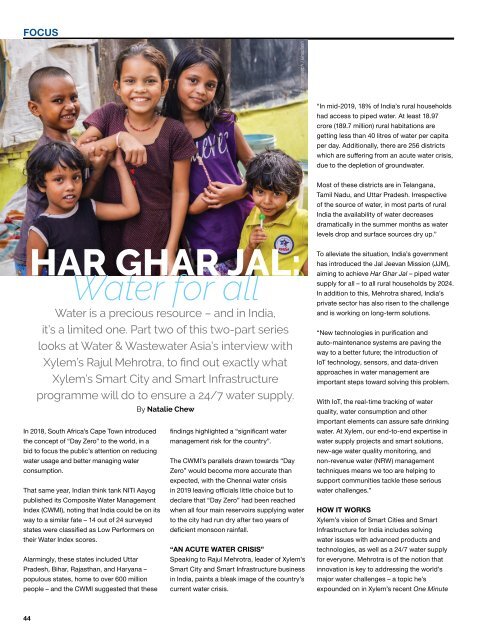Water & Wastewater Asia March/April 2021
Water & Wastewater Asia is an expert source of industry information, cementing its position as an indispensable tool for trade professionals in the water and wastewater industry. As the most reliable publication in the region, industry experts turn this premium journal for credible journalism and exclusive insight provided by fellow industry professionals. Water & Wastewater Asia incorporates the official newsletter of the Singapore Water Association (SWA).
Water & Wastewater Asia is an expert source of industry information, cementing its position as an indispensable tool for trade professionals in the water and wastewater industry. As the most reliable publication in the region, industry experts turn this premium journal for credible journalism and exclusive insight provided by fellow industry professionals. Water & Wastewater Asia incorporates the official newsletter of the Singapore Water Association (SWA).
Create successful ePaper yourself
Turn your PDF publications into a flip-book with our unique Google optimized e-Paper software.
FOCUS<br />
Photo credit: loren joseph / Unsplash<br />
“In mid-2019, 18% of India’s rural households<br />
had access to piped water. At least 18.97<br />
crore (189.7 million) rural habitations are<br />
getting less than 40 litres of water per capita<br />
per day. Additionally, there are 256 districts<br />
which are suffering from an acute water crisis,<br />
due to the depletion of groundwater.<br />
Most of these districts are in Telangana,<br />
Tamil Nadu, and Uttar Pradesh. Irrespective<br />
of the source of water, in most parts of rural<br />
India the availability of water decreases<br />
dramatically in the summer months as water<br />
levels drop and surface sources dry up.”<br />
HAR GHAR JAL:<br />
<strong>Water</strong> for all<br />
<strong>Water</strong> is a precious resource – and in India,<br />
it’s a limited one. Part two of this two-part series<br />
looks at <strong>Water</strong> & <strong>Wastewater</strong> <strong>Asia</strong>’s interview with<br />
Xylem’s Rajul Mehrotra, to find out exactly what<br />
Xylem’s Smart City and Smart Infrastructure<br />
programme will do to ensure a 24/7 water supply.<br />
In 2018, South Africa’s Cape Town introduced<br />
the concept of “Day Zero” to the world, in a<br />
bid to focus the public’s attention on reducing<br />
water usage and better managing water<br />
consumption.<br />
That same year, Indian think tank NITI Aayog<br />
published its Composite <strong>Water</strong> Management<br />
Index (CWMI), noting that India could be on its<br />
way to a similar fate – 14 out of 24 surveyed<br />
states were classified as Low Performers on<br />
their <strong>Water</strong> Index scores.<br />
Alarmingly, these states included Uttar<br />
Pradesh, Bihar, Rajasthan, and Haryana –<br />
populous states, home to over 600 million<br />
people – and the CWMI suggested that these<br />
By Natalie Chew<br />
findings highlighted a “significant water<br />
management risk for the country”.<br />
The CWMI’s parallels drawn towards “Day<br />
Zero” would become more accurate than<br />
expected, with the Chennai water crisis<br />
in 2019 leaving officials little choice but to<br />
declare that “Day Zero” had been reached<br />
when all four main reservoirs supplying water<br />
to the city had run dry after two years of<br />
deficient monsoon rainfall.<br />
“AN ACUTE WATER CRISIS”<br />
Speaking to Rajul Mehrotra, leader of Xylem’s<br />
Smart City and Smart Infrastructure business<br />
in India, paints a bleak image of the country’s<br />
current water crisis.<br />
To alleviate the situation, India’s government<br />
has introduced the Jal Jeevan Mission (JJM),<br />
aiming to achieve Har Ghar Jal – piped water<br />
supply for all – to all rural households by 2024.<br />
In addition to this, Mehrotra shared, India’s<br />
private sector has also risen to the challenge<br />
and is working on long-term solutions.<br />
“New technologies in purification and<br />
auto-maintenance systems are paving the<br />
way to a better future; the introduction of<br />
IoT technology, sensors, and data-driven<br />
approaches in water management are<br />
important steps toward solving this problem.<br />
With IoT, the real-time tracking of water<br />
quality, water consumption and other<br />
important elements can assure safe drinking<br />
water. At Xylem, our end-to-end expertise in<br />
water supply projects and smart solutions,<br />
new-age water quality monitoring, and<br />
non-revenue water (NRW) management<br />
techniques means we too are helping to<br />
support communities tackle these serious<br />
water challenges.”<br />
HOW IT WORKS<br />
Xylem’s vision of Smart Cities and Smart<br />
Infrastructure for India includes solving<br />
water issues with advanced products and<br />
technologies, as well as a 24/7 water supply<br />
for everyone. Mehrotra is of the notion that<br />
innovation is key to addressing the world’s<br />
major water challenges – a topic he’s<br />
expounded on in Xylem’s recent One Minute<br />
44


















